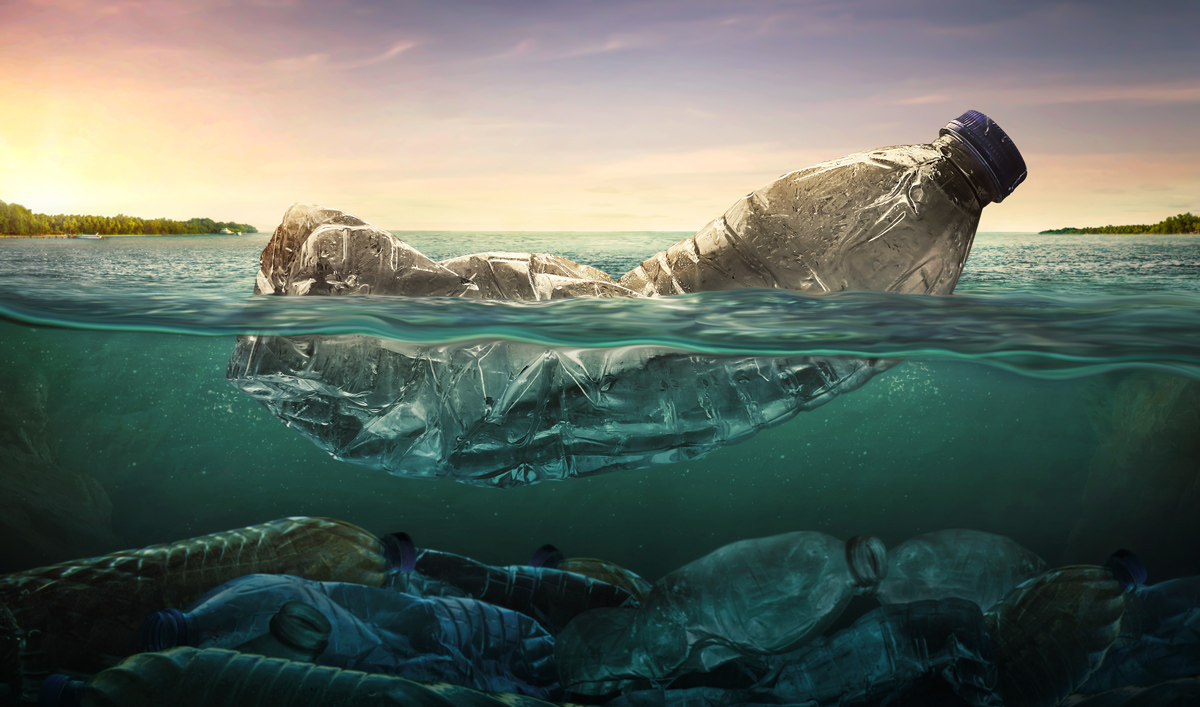Every straw counts: Plastic and the oceans

Nobody counts it, no nation weighs it. So let’s make do with an informed guess: roughly a truck-load per minute, between five and 13 million tons per year: that’s how much plastic garbage ends up in the oceans. Where it lingers for hundreds of years, degrading to form macro- and microplastic which then ends up in the digestive systems of fish and, further down the chain, humans, marine mammals and birds; some of it is washed up on beaches or drifts through the world’s oceans in one of five great garbage patches. According to one study, in terms of weight, by 2050 there will be more plastic swimming in the sea than fish.
Alongside climate change, plastic is one of the biggest environmental concerns of our era. It is, in fact, part of the bigger climate problem and it is something that we humans are entirely and solely responsible for. It all started so promisingly: plastic was progress, plastic was the future. It was a new material with an unprecedented degree of versatility. Within the space of a few decades, it transformed the way we clothe ourselves, how we eat our food, how we furnish our houses and get from A to B. It conquered the world and all aspects of our lives – from telephones to nylon tights, from dental floss to car tyres and drainpipes.
A boon and a curse: plastic
Plastic production on a large scale started in the 1950s. Back then, the total volume was around two million tons a year; today, Coca-Cola alone uses three million tons annually. By 2018, the global production of plastic was over 330 million tons, and that figure is expected to rise to 400 million next year. The eagerly welcomed boon has long since become a curse.
Instead of establishing a circular economy, where as much of the plastic is recycled and reused as possible, for years the approach has been simply to keep on producing more and more plastic, using it – and then throwing it away. Since 1950, globally only nine per cent of the plastic that has been used has actually been recycled. Worldwide, the present recycling ratio of plastic packaging is a derisory 14 per cent. And quite apart from all the waste, every year the production and incineration of plastic generates around 400 million tons of carbon emissions.
Whether it’s the Yangtze or the Yellow River, the Indus, Ganges or Brahmaputra, Amur, Mekong, Nile or Niger: it is estimated that half of the plastic that ends up in the world’s oceans every year comes from a total of ten rivers, most of which are in Asia. The rest is blown into the sea by the wind – or comes from people throwing their plastic waste into the water. At the UN Environmental Conference in Nairobi in March 2019, plastic waste in the oceans was high up on the agenda. Ultimately, though, the conference ended without a joint resolution: the participants could not even agree to start negotiations.
Small rays of hope – or merely scratches on the surface?
Confronted by the reality of a vast sea of waste, people are attempting to make a change. For example, with experiments like “The Ocean Cleanup”, which aims to remove plastic from the Pacific Ocean using a mechanical collection device. With a fleet of 60 systems, believes the Dutch inventor, half of the plastic waste in the great garbage patch in the Pacific could be collected in five years. It is unclear whether this prognosis includes the new waste that is being added every day. There are campaigns like the annual International Coastal Cleanup Day: nearly one hundred countries and countless national organisations take part and clean up “their” beaches. The Canadian start-up Hoola One has invented a gigantic beach vacuum cleaner that efficiently filters the plastic waste from the sand on the beach. Thanks to all these projects and campaigns, the problem is out of sight – at least temporarily.
The Canadian Plastic Bank is taking a different approach: all around the world in places where poverty and plastic waste coexist as serious problems, it aims to tackle both simultaneously. Collected plastic is exchanged for cash or products or swapped for blockchain-secured digital cash. And there are companies who believe that recycling is the answer. For instance, outdoor gear maker Patagonia: 69% of the materials the brand uses are recycled, and by 2025 it aims to increase this to 100%. A pair of Parley shoes by Adidas corresponds to 11 recycled plastic bottles. And even Coca-Cola wants to recycle a bottle or can for each one it sells by 2030. It’s a start.
Another approach is the STOP project launched by the industry, which is focussing on establishing low-cost waste management systems in Asia in order to avoid littering with plastic trash. Initiatives like The New Plastics Economy Global Commitment use the clout of multinational organisations: this programme currently unites more than 400 business, NGOs, governments and citizens in order to tackle the problem of plastic at source with targeted measures and ideas on recycling and reusing plastic packaging.
Good intentions and targeted action
Behind these efforts is usually the United Nation’s Agenda 2030 for Sustainable Development, a declaration of intent that specifically includes the protection of the oceans as “Goal 14”. The UN’s special agency for shipping, the International Maritime Organization (IMO), is also taking action. In 2018, its committee for the protection of the marine environment passed an action plan for the disposal of plastic waste on ships. The measures are due to be completed by 2025 and will affect all ships, from fishing boats to gigantic cruise liners. That being said, the disposal of plastic waste into the sea has long been prohibited by international regulations (MARPOL).
But apart from establishing the use of complex equipment on board to store and treat waste until it can be disposed of on land, plastic is a problem that needs to be tackled at the root. The answer is avoiding plastic altogether – and that includes the cruise industry.
For TUI Cruises the environmental targets set by the UN are an important guideline. In 2018, the cruise line launched a comprehensive company-wide programme for the avoidance of plastic rubbish called WASTELESS. Lucienne Damme, Environmental Manager at TUI Cruises, explains the programme: “Partners and suppliers, the staff on land and the crew members on board, and, ultimately, the guests on board the Mein Schiff® fleet – everyone is being included in this scheme. By the end of 2020, we aim to eliminate single-use and plastic products from our operations to the greatest extent possible or to replace them with eco-friendly alternatives, like bio plastics, multi-use items, bulk packaging, dosage and refillable systems. All remaining plastic waste will, of course, be recycled.”
Switching from plastic to wooden stirrers saves around 1.5 million plastic stirrers a year across the TUI Cruises fleet. Five million plastic drinks stirrers are no longer used, and neither are 250,000 plastic covers for the Mein Schiff® slippers, which are now presented without packaging. The introduction of dosage systems for toiletries in the cabins has eliminated the need for 380,000 little plastic bottles per year. In the ship’s shops, roughly 200,000 plastic and paper bags a year have been replaced with reusable Mein Schiff® beach bags made of recycled PET or with reusable branded shopping bags. The morning newspaper is no longer delivered to the cabin door in a plastic bag, but hung from the door handle with a reusable hemp string, saving a further 51,100 plastic bags a year.
The numbers that these changes bring are truly impressive, and particularly so because nearly all the big cruise lines have been taking a long, informed look at the issue and are making changes.
The No. 1 on the German market, AIDA, has also put single-use items and the avoidance of plastic on its agenda. “Reducing and, where possible, complete avoidance of plastic has been a key part of our sustainability strategy for many years”, says Hansjörg Kunze, Vice President Communication & Sustainability. This development is noticeable for passengers and crew on board the ships. Single-use cups and lids have been replaced with multi-use cups; disposable plastic cutlery is taboo. Since 2013, paper bags have been used instead of plastic ones, drinking straws or swizzle sticks are made of bio-degradable starch or wood, and microplastic has long since been banned in toiletries and spa products. Biscuits served with coffee are no longer individually wrapped, and laundry is delivered from the cleaners without a plastic cover. These are only a few of the many measures put in place which are making life on board more sustainable.
For AIDA, this is a constant process and changes are being made in many different areas. Hansjörg Kunze explains: “We are continually conducting surveys across the fleet to determine where we can switch from single-use and plastic products to bio-degradable or multi-use ones.”
MSC is also committed to making changes. “MSC Cruises has opened a new chapter in its environmental commitment”, reports Christian Hein, Managing Director of MSC Cruises in Germany. “We have pledged to stop using disposable plastics and, wherever possible, to introduce sustainable alternatives.” Since March 2019, disposable plastic bags, spoons, jars and other items have been replaced with eco-friendly alternatives. Single portions in plastic packaging, like butter, jam or yoghurt, have become a thing of the past. Disposable straws have been banished and replaced with sustainable alternatives. This practice has not only been established on board the ships, but also on all island destinations, in the MSC offices on shore and on MSC shore excursions. “It’s a long-term, continuous commitment. Where sustainable solutions for specific products are not yet available, we ensure that all plastic waste is recycled in the most effective way. Our processes are checked and certified by external experts”, Hein adds.
Costa Cruises is taking a similar approach. On board and on land, in food and beverages, diposable plastic items are being replaced by ones made of bio-degradable, compostable “Mater-Bi” or wood. Wherever possible, packaging and food containers are reused. On the buffets, yoghurt comes from dispensers instead of individual pots; in cabins, soap and shampoo dispensers have replaced plastic bottles and caps. Microplastics have been banned from toiletries and spa products. In the ships’ kitchens, dishwasher tabs are used instead of liquid dishwashing detergents, which significantly reduces the amount of plastic packaging consumed. Cleaning agents come in concentrates, and the bottles are reused, reducing the need for plastic and cutting transport and energy costs.
Reduce and recycle is also is the name of the game at Hapag-Lloyd Cruises: plastic bags, drinking straws and swizzle sticks are no longer used or are made of wood; plastic waste is collected separately and disposed of professionally on land. The suites of the new expedition ships come with complimentary refillable water bottles which guests can also use for shore excursions.
In other areas, care is also being taken to use alternatives to plastic. For instance, the kayaks on board the new expedition ships are made of HTP, a very robust and durable polyethylene. No waste is generated when the hulls are built, and the producer also takes the boats back for recycling free of charge. The expedition line also impressively shows how passengers can engage and participate: every time one of the ships visits Spitsbergen, Hapag-Lloyd Cruises participates in the “Clean up Svalbard” initiative and, together with the passengers, collects garbage – especially plastic – that washes up on the coast of Spitsbergen.
The fight against plastic has become an important element in the cruise lines’ comprehensive sustainability efforts. Individually, none of these projects will solve the problem of plastic, but in the greater picture every little detail counts. The schemes introduced by the cruise lines show that something is happening and that every individual passenger can help to avoid plastic – and that’s a great first step for the oceans of the world.
But obviously we still have a long, long way to go before we can truthfully give the all-clear signal for either the oceans or land. The Plastic Atlas recently published by the Heinrich Böll Foundation states bluntly: “Many people are aware of the issue of microplastic in the oceans. But what fewer people know is that, depending on the location, the contamination of the soil and inland waters is between four and 23 times as high as in the ocean.”
Spectacular endeavours by individuals ensure that the problem of increasing marine pollution remains in the headlines. In The Vortex Swim, Ben Lecomte has set out to swim through the Transatlantic garbage patch – 300 nautical miles in total. He was forced to abandon his 2018 attempt due to bad weather. https://benlecomte.com
Photos:
(c) Shutterstock




